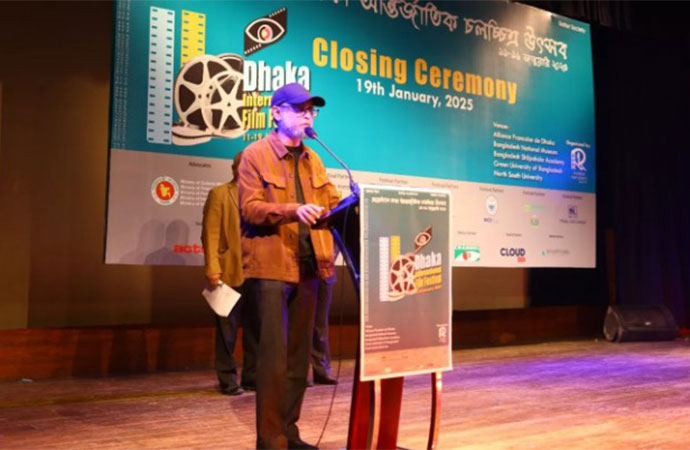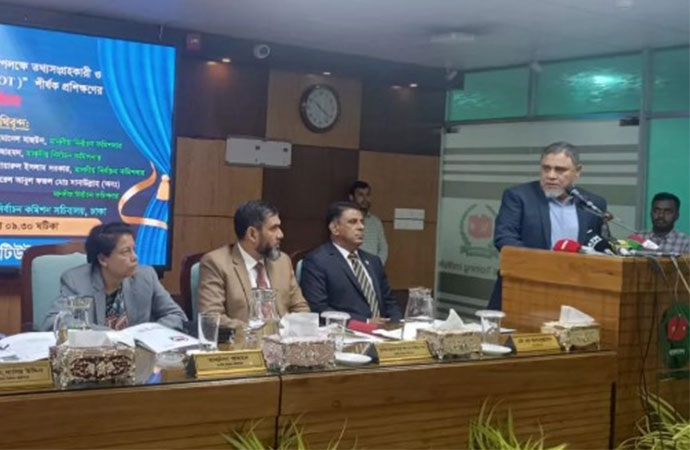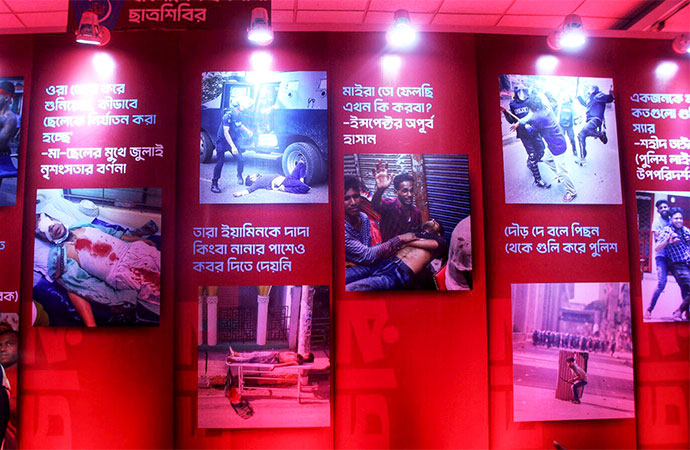Featured 2





An Interactive, cosmopolitan renaissance on display in Koen Vanmechelen's solo exhibition at Brihatta
On Saturday, November 4, an exclusive solo exhibition of Belgian artist Koen Vanmechelen titled "Dream of Human Nature" opened at the Brihatta Art Foundation, a young artist-run, research-based platform based in Dhaka with a strong focus on community development and collaboration, located at Mukti Tannery 1's rooftop in the Hazaribagh Tannery Area in the capital. The interactive exhibition, organised and hosted by the Brihatta Art Foundation and curated by renowned Bangladeshi artist and art educator Bishwajit Goswami, is a convergence of art, science and community that invites visitors to actively discover nature as a library of knowledge.
With this exhibition, the visiting Belgian artist Koen Vanmechelen unveils the essence of his ongoing Cosmopolitan Chicken Project (CCP), through his latest chicken crossing, the 'Mechelse Aseel'. The CCP is an ongoing trans-disciplinary art project started in the late 1990s which aims to create a hybrid of all races of chicken in the world.
Introducing the Mechelse Aseel - CCP28:
"Not just a chicken, but a piece of art!"
On October 4 this year at World Animal Day, Brihtta announced that its space will soon become the temporary home of a chicken. Introducing the chicken, it stated: "The Mechelse Aseel - CCP28 is the newest generation in artist Koen Vanmechelen's Cosmopolitan Chicken Project (CCP). What in the 90s started as a way to illustrate metaphorical ideas about diversity and multiculturalism has led to the creation of a bird that, according to the artist and backed by the scientists working on the project with him, tends to be healthier, live longer, and be more adaptable to a changing environment than purebred chickens. The Mechelse Aseel - CCP28 is born out of the crossing of the Mechelse Haughaesni - CCP27 and the Aseel, a breed of fowl that originated in Bangladesh."
This captivating chicken's diversity is meticulously captured in "Open Secret; a book made with the use of avant-garde DNA-mapping technologies which Brihatta quotes as "An ode to our planet's diversity and an archive of decades of crossing." The chicken genome contains more than a billion nucleotides, composed of the four letters of the DNA alphabet. Lined up in a specific order, they make up a code. For this book, the DNA sequence of the Mechelse Aseel-CCP28 was compared to the scientific standard, and genetic diversity was marked when the DNA sequence of the chickens differed. The book's letters indicate where the genetic makeup differs from the reference chicken genome. The result shows the increasing hybridity of the CCP.
The Exhibition: connecting the dots
Brihatta Art Foundation invited Koen Vanmechelen for this fall exhibition who has been working for over 20 years at the intersection of art, community, and science. This exclusive exhibition, according to the artist and Brihatta, is an invitation to learn more from nature regarding the eternal existence of human beings and how people can dream and create a more sustainable future. Koen's passion is based on the belief in art as a driver of mutual understanding and as a guide in the search for answers to the significant challenges of the 21st century, the relationship between nature and culture, and, in particular, the development of sustainable communities.
"I embrace my role as an artist in shaping a harmonious world," artist Koen Vanmechelen stated. "The exhibition's intricate tapestry celebrates humanity's diversity, inspiring us to cherish our dreams with a mindful perspective of our nature. In this convergence of art, science, and community, I find hope for a future built on unity and understanding. And I hope visitors will experience the same."
Positioned within Bangladesh's cultural hub, the exhibition seeks to explore how humans live, the dreams they harbour, and the imperative need to tether those dreams with the reality of their existence.
Vanmechelen is thrilled to exhibit in Bangladesh for the first time, saying, "It is a fascinating place of ancient civilisations and enormous biocultural hybridity. Through genetics and collaborative art, the exhibition reflects our interconnectedness and calls for sustainable coexistence."
Dream of Human Nature:
The exhibition offers an interestingly interactive take, unlike the traditional ones. In the central chicken cage, brood lamps hang; and many electrical cables converge at one particular point. They are connected to imposing megaphones and 28 television screens that fill the wall. On these television sets, people representing the countries that make up the diversity of the CCP project read aloud the series of letters and numbers composing the Open Secret book in the video work DECODE.
With the installation, the artist creates a wall of chatter, a modern Tower of Babel, about human DNA - as a mantra for an ongoing process. Vanmechelen defines, "In an era in which the mass dissemination of images has detached us from reality, and digital communication replaces the 'human voice' - I use the power of seemingly unconnected sounds to weave a web of meaning; what we construct is intertwined with language and communication. However, just like applied mathematics, which has led to creation and destruction, language should be used wisely. Every syllable counts."
While 'Open Secret' lies at the heart of the exhibition, a second DNA book forms the base of a collaborative art project involving creativity, spirituality and community up in the Bangladesh hill tracts. For 'Shagga," the book, Vanmechelen collaborated with scientists to sequence the genome of a White Eared-Pheasant, also called Shagga by the indigenous people of The Himalayas. This near-threatened bird species lives close to or above the snowline and can often be found around Buddhist monasteries. Because of its purity, it is seen as a symbol of spirituality.
During his last visit to Bangladesh, Vanmechelen invited Buddhist monasteries to copy parts of the DNA book by hand. It is a project that aims to bring attention to the importance
of spirituality in our lives and the need to find a balance between progress and spirituality. Defining all these, Vanmechelen stated: "The monks accepted my invitation. They understand the dynamics of animals and humans and know the image of the pheasant, lonely on a mountain. They understand that an animal can change your way of thinking and that this can be done through understanding the essence of DNA. It is a different way of looking at life. Together with the Cosmopolitan Chicken, the White-Eared pheasant taught me that spirituality and creativity are essential. The building blocks of our dreams of human nature."
What Came First: An Artful Journey
The exhibition also offers its visitors to take part in the creative journey, as the organizers said:
"Join us this November for an immersive exploration at our art space and step into this age-old debate through clay painting. Come paint clay chickens and eggs with your loved ones, infusing each piece with a unique identity celebrating coexistence. Unleash creativity on the canvas of art and sustainability with 1000 clay chickens and 1000 eggs, crafted by Rajshahi's artisans for our Cosmopolitan Chicken Project (CCP). This was a special collaboration with a Potter community in Rajshahi, led by Artisan Subodh Kumar Pal. Let's paint a harmonious world together, nurturing the dream of human nature's sustainability."
Bishwajit Goswami, the Curator:
"To dream is part of human nature.
Whether we dream in states of conscious or unconsciousness, we construct and deconstruct ourselves according to our deepest desires, wishes and fantasies. We consent to idealized ways of thinking, being and seeing, only to find ourselves in altered ways of existing in real life.
We dream of a world where diversity and inclusivity can coexist.
Artist Koen Vanmechelen touches on this with his Cosmopolitan Chicken Project, using the chicken as a metaphor for humanity and social processes, advocating identity and diversity across borders.
Diversity is an ongoing conversation. This exhibition gives us space to contemplate the subject momentarily, with a slight pause. Koen has developed a unique process where different communities can engage through art, science, and spirituality; in line with the natural flow of life, as Mother Nature intended.
A new language is created, where one feels, rather than sees, beauty as a form of art. A new composition created in harmony with our surroundings, in which the 28th generation of the CCP, Mechelse Aseel, is used as a metaphoric expression to nurture his dream of a diverse world.
The dream, which 20 years ago transported him to a monastery in the Himalayan region in search of the White Eared-Pheasant, now brings him to Bangladesh on a quest to seek the familiar in an unfamiliar setting. Similar to the journey of a stream that flows from the Himalayas to form rivers which merge into oceans, the spirit of the Mechelse Aseel wanders from Belgium to artisanal grounds of Rajshahi, to sacred lands in the Chittagong hill tracts.
Brihatta Art Foundation and Koen Vanmechelen present the process of creation in a unique way to the audience in Bangladesh; a process in which the convergence of art and science garner responses of empathy, unity and deep contemplation."
Nusrat Mahmud, co-founder of Brihatta Art Foundation echoed the same, as she stated: "To dream is what we dare to do in Brihatta. In our subconscious minds, we are gently laying the bricks to a future which unites us in unconventional ways, for us to be able to realise our full potential as human beings. We are beyond excited to host Koen and CCP in Hazaribagh, and our collaboration with Koen and the local community gives us hope to continue our activities within the art space in Bangladesh and beyond."
Art Talk:
Before the opening of this exclusive exhibition, a special Art Talk, moderated by Brihatta co-founder Nusrat Mahmud, was held at the venue on Saturday titled "Cosmopolitan Chicken, Cosmopolitan Human: In Conversation With Koen Vanmechelen" which was joined by Dr Haseena Khan, Independence Day Award-winning scientist, Professor and fellow at Bangladesh Academy of Sciences, and eminent artist-art critic Mustafa Zaman.
Honoured with the Independence Day Award for her unique contribution to research and training, Dr Haseena Khan was one of the team leaders of the jute genome project, the first major genome project in Bangladesh. Along with the help of an international team, her group also decoded the Hilsa fish genome and was the first to publish the genome findings. "We are all made out of the same 4 elements; ACGT (Adenine, Cytosine, Guanine, and Thymine). All living things. And even more so, I am not what I am because of me, others make me to be what I am. We should be humbled by those facts Science tells us that and Koen's art says it as well," Dr Haseena Khan said at the event.
Mustafa Zaman, a renowned and versatile artist, art critic, and former editor at Depart magazine, said: "This hybrid space is unique, it goes beyond the passive consumption of art that we are used to. Being confronted with this installation, you struggle to understand. You need to understand the different elements - science, community, art - and question yourself what Koen sees in this chicken. That is a game changer. Out of that, a new conversation is born."
The exhibition will be open to all till November 30, from 3 pm to 8 pm - except on Thursday.

























Leave a Comment
Recent Posts
Showcasing tradition, creative ...
With a commitment to reviving traditional crafts and fostering creativ ...
Gallery Cosmos hosts special s ...
Celebrating a vibrant winter evening of cinematic art and storytelling ...
Logic of interdependence, mutual benefit to keep gui ..
The most important deliverable on the IG’s plate
All 64 people aboard an American Airlines jet were k ..
Tensions between Dhaka University and its seven affi ..